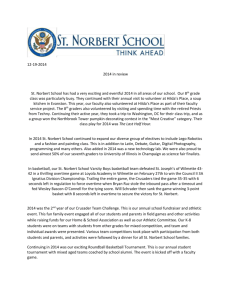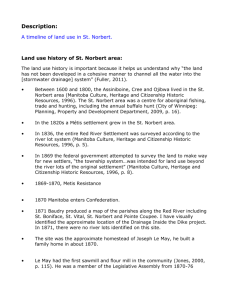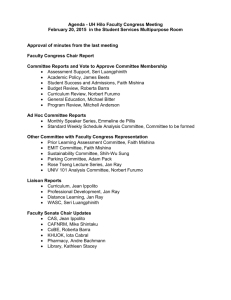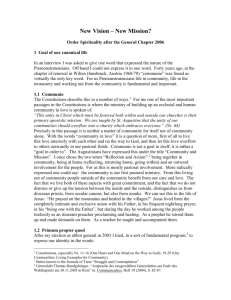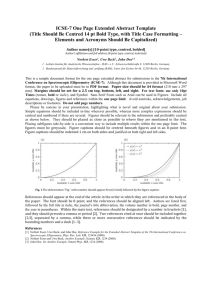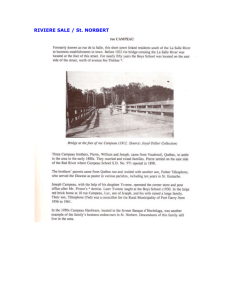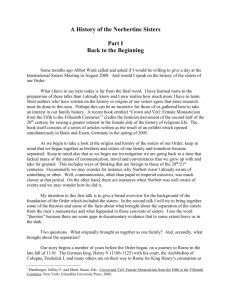Third Conference (written by Father Theodore Antry, O.Praem
advertisement
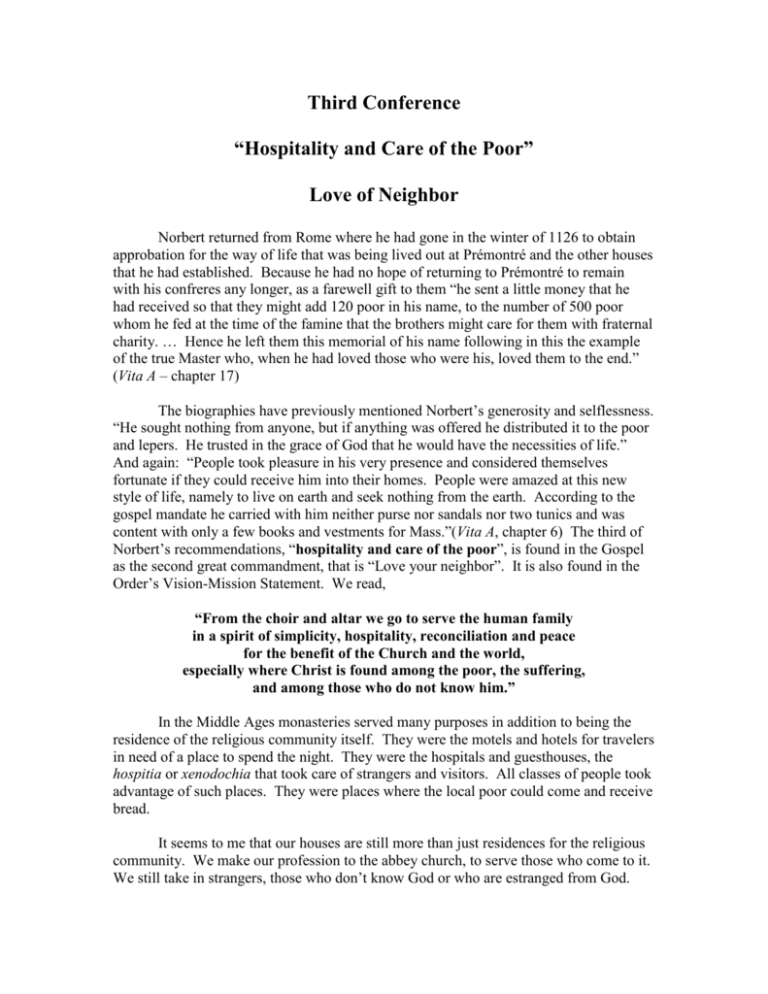
Third Conference “Hospitality and Care of the Poor” Love of Neighbor Norbert returned from Rome where he had gone in the winter of 1126 to obtain approbation for the way of life that was being lived out at Prémontré and the other houses that he had established. Because he had no hope of returning to Prémontré to remain with his confreres any longer, as a farewell gift to them “he sent a little money that he had received so that they might add 120 poor in his name, to the number of 500 poor whom he fed at the time of the famine that the brothers might care for them with fraternal charity. … Hence he left them this memorial of his name following in this the example of the true Master who, when he had loved those who were his, loved them to the end.” (Vita A – chapter 17) The biographies have previously mentioned Norbert’s generosity and selflessness. “He sought nothing from anyone, but if anything was offered he distributed it to the poor and lepers. He trusted in the grace of God that he would have the necessities of life.” And again: “People took pleasure in his very presence and considered themselves fortunate if they could receive him into their homes. People were amazed at this new style of life, namely to live on earth and seek nothing from the earth. According to the gospel mandate he carried with him neither purse nor sandals nor two tunics and was content with only a few books and vestments for Mass.”(Vita A, chapter 6) The third of Norbert’s recommendations, “hospitality and care of the poor”, is found in the Gospel as the second great commandment, that is “Love your neighbor”. It is also found in the Order’s Vision-Mission Statement. We read, “From the choir and altar we go to serve the human family in a spirit of simplicity, hospitality, reconciliation and peace for the benefit of the Church and the world, especially where Christ is found among the poor, the suffering, and among those who do not know him.” In the Middle Ages monasteries served many purposes in addition to being the residence of the religious community itself. They were the motels and hotels for travelers in need of a place to spend the night. They were the hospitals and guesthouses, the hospitia or xenodochia that took care of strangers and visitors. All classes of people took advantage of such places. They were places where the local poor could come and receive bread. It seems to me that our houses are still more than just residences for the religious community. We make our profession to the abbey church, to serve those who come to it. We still take in strangers, those who don’t know God or who are estranged from God. 2 Our abbeys, priories and convents are spiritual hospitals, for those who need God’s healing. Our caring for the poor may be different today. Many of our houses include spirituality centers instead of hospitia and xenodochia. We don’t serve as hospitals for the physically ill but as places of healing and recuperation for those who need someone to talk to, to confess to, to open their hearts to, and in turn to receive the healing balm of God’s grace. The third paragraph of the Vision-Mission Statement is very powerful. But it does not stand by itself. It depends on the first two paragraphs and develops from them. From a decision to follow Christ according to the charism of Norbert, we grow as a community in “Communio” through a never-ending conversion of the members and finally move outward to serve. Canons seek God within and then move outward to others. All that they have learned about God they share with others teaching them by the words and example of their lives, “docere verbo et exemplo”. This surely includes works of charity, hospitality, reconciliation, healing and bringing people closer to God. Our Abbot General, Abbot Thomas, in his commentary on the Vision-Mission Statement that is entitled “New Vision – New Mission? Order Spirituality after the General Chapter 2006”, writes: “There is no encounter with the divine that would not become mission. All biblical reports about experiences of God indicate this. Whoever falls under God’s influence receives a task, a mandate, a responsibility, a mission: ‘Go to my brothers and announce to them: I go to my Father and your Father, to my God and your God’ (Jn 20: 17b). That is the mandate to Mary Magdalene after her encounter with the Risen One. Mary Magdalene, a woman, becomes the first messenger of the resurrection. That remains the basic mission for us as Christians who were baptized into the crucified and risen Lord Jesus Christ. As Premonstratensians in the white habit, which recalls the angel of the resurrection in the Gospel, we feel especially obligated to this mission. The Statement presents us with four mission areas: our service for reconciliation and peace, our service for the building up of the church and community, our service for the poor, suffering and our mission to those who do not yet know God – four milestones for our pastoral, missionary and active work.” (Section 2.3 Mission) As I mentioned previously, this third paragraph of the Vision-Mission Statement develops from the previous two paragraphs. In the first paragraph we declare that, “we are called as baptized to follow the poor and risen Christ … according to the Gospel, the rule of Saint Augustine and the charism of Saint Norbert….” If we are indeed called to model our lives according to the charism of Norbert, we should be able to find these four milestones lived out in his life. And in fact we do. 3 Norbert’s service to the human family: 1. Service for reconciliation and peace: It is precisely in this area that Norbert was known during his own lifetime. Both Vitae refer to him as a “Minister of peace and concord”. And there are several fully developed stories in these biographies that tell of his efforts in this area, some more successful than others. The most well known is the reconciliation at Moustier. It is more familiar to us because this event was portrayed by the brothers Cornelius and Theodore Galle in their series of engravings of the life of Norbert. The particular engraving shows two noblemen taking an oath of reconciliation in the presence of the church’s relics (engraving # 13). But there is also the story of Norbert preaching in the village of Couroy. The biographer writes: “After the celebration of Mass Norbert spoke about peace and concord, as was his custom. He began with humble exhortation, to recall some who were at odds with one another due to their old quarrels. In spite of the request, one of them, unwilling to make peace, got up and ran outside. Jumping onto his horse, he attempted to flee. The horse, however, although vigorously spurred, refused to move. The crowd began to gather, some out of curiosity, some to mock, some were weeping. The man himself, shaken, returned to the church and, prostrate, asked pardon.” (Vita A, chapter 8) 2. Service for the building up of the church and community: This is an area that would be central to Norbert’s whole life’s work after his conversion. Norbert worked during the period of the Gregorian Reform. During his days as an itinerant preacher his reputation was so great that people would gather not only to hear him say Mass and preach but afterwards to ask questions regarding different religious practices. (Vita B, chapter 13) As founder of Prémontré and other houses he renewed canonical life for his followers by taking on the Rule of Saint Augustine and restoring the life of the early Church as found in the Acts of the Apostles. He preached against erroneous beliefs regarding the Eucharist in Antwerp. As archbishop of Magdeburg he worked to upgrade the faith and religious practices of his diocese; he reformed monasteries and established new ones. And in line with the Gregorian Reform program: “He demanded that chastity be observed in every way by deans and priests and those who had to direct the people and by all those advanced to sacred orders. He forced them either to hold to this or, if their actions became publicly known, to relinquish all ecclesiastical benefices.” (Vita B, chapter 44) 3. Service for the poor and suffering: With great pride Norbert would refer to Prémontré as domus paupertatis, his house of poverty. It was the time of the pauperes Christi movement and the cry was “naked to follow the naked Christ”. To give up everything and have Christ alone as your leader – Christo solo duce. I have already mentioned how, after his conversion – especially after the Fritzlar experience – Norbert gave up his benefices, sold his possessions and gave the money to the poor. Later, when someone gave him something he gave it away for the care of the poor and lepers. 4. Mission to those who do not yet know God: Here we can mention the fact that throughout his life, after his conversion, Norbert remained an itinerant preacher. This is 4 so even after he founded Prémontré. As archbishop his missionary view extended far beyond the Elbe River toward the pagan peoples in the East. He began to lay foundations for this missionary work but unfortunately he was called home to God after only eight years as archbishop. Our service to the human family: Just as the first paragraph of the Vision-Mission Statement spoke of the “charism of Norbert”, so the second paragraph concerns our “never-ending conversion”. It is the way in which we build up our strength in Christ through prayer and the Eucharist in order to strengthen the “Communio” of our churches so that we in turn may go out to serve the human family. We have seen how Norbert fulfilled in his life the four milestones mentioned in the third paragraph of the Statement. We have to take the core element of that “story we have to tell” and bring it forward to our own time. We have to make Norbert’s enthusiasm come alive for us today. How do our communities do this? People gathered to hear Norbert preach. They saw something different in him. Once again, both biographies remark that people were amazed “at this new type of life, to live on earth and to have nothing and to seek nothing from the earth”. (Vita A, chap. 6; Vita B, chap. 13) Today, people are just not coming to churches. We have the example of two model priests who were very influential in converting the hearts of those whom they encountered. The first of course is our own founder and patron, St. Norbert. The second is St. John Marie Vianney, whom Pope Benedict has proposed for us as a model during this “Year for Priests”. Both men began their work at a time when there was a great need for good priests. Norbert during the Gregorian Reform; John Marie Vianney in the aftermath of the French Revolution. Norbert travelled throughout Europe. John Vianney served his entire priestly life in one place. We are called to minister at a time of deep decline in faith and love of God. You, the prelates of our Order, who are gathered here this week, come from six continents around the world. Each of you in your individual canonries responds to somewhat different needs depending on the country and area of that country in which your canonry is located. Nevertheless in varying degrees this recommendation of Norbert “to be hospitable and care for the poor”, as expressed in the Vision-Mission Statement, applies to all of you. Each canonry, large or small, no matter where it is located at some time has encountered, is now encountering or will encounter the poor, the unbelieving, those at odds with one another and those who need encouragement. 1. Service for reconciliation and peace: We have an expression in English, “charity begins at home”. Applying this to the topic of reconciliation and peace, I think we are called to be reconciled to one another in our own canonries where this is necessary. Since we are all human, subject to various and sundry frailties, it is hard to imagine that there is a canonry or monastery anywhere in the world that does not have some conflict to settle. Then, no matter where we work – parishes, schools, missions, counseling 5 programs or retreat houses – the business of reconciliation and peacemaking is a broad field of action. Even among groups working toward the same goal there can be conflicts. 2. Service for the building up of the church and community: Many of our abbeys have developed retreat centers in the past thirty or forty years. Some have laymen and laywomen working with them in these centers. They participate in the choir prayer and Eucharist that is celebrated in the abbeys and priories. They function in various capacities as spiritual directors, hospitality teams, etc. Many houses have developed groups of associates, participants, oblates and third order members who share in some capacity or other in the prayer and work of the houses of the Order. At Daylesford we have some priest associates, local pastors, who share our days of recollection and other abbey activities. Since they are working alone in their parishes this is a source of spiritual support for them. 3. Service for the poor and suffering: I mentioned at the beginning of this conference that in the middle ages local poor people would come to an abbey to receive a meal, frequently in the form of bread. People still come to religious houses and ask for food, especially from houses located in urban areas. Some houses have set up “soup kitchens” or places, particularly in parish situations, where people can come for bags of food or perhaps coupons that they can take to a supermarket to purchase food. Some abbeys have set up overnight or even permanent housing for the homeless. Abbeys have set up systems of tithing in order to have money set aside for people who are in dire need. 4. Mission to those who do not yet know God: For Norbert, the world was his church. For John Marie Vianney the church itself was his home. Both men bore witness to their faith verbo et exemplo, by word and example. The life that they modeled for others supported the words that they spoke. Many in the world today still do not know of Christ, perhaps have never heard of him. But far too many no longer know Christ. What would Norbert do for these people? What should we be doing for them? How will we bring them back to Christ? Pope Benedict in his letter proclaiming the “Year for Priests” writes that this year is “meant to deepen the commitment of all priests to interior renewal for the sake of a more forceful and incisive witness to the Gospel in today’s world…” Is this not part of our promise of “a conversion of my ways” or “never-ending conversion”, a conversion that leads to greater “Communio” and ultimately makes each of us and our communities better witnesses verbo et exemplo, in word and example? In the conclusion of his commentary on the Vision-Mission Statement, Abbot Thomas writes: “The Statement breathes fully our Premonstratensian spirituality, contains something of the early church radicalism and above all breathes the spirit of St. Norbert, to whom credit is due precisely in his reform efforts to actualize the spirit of the early Church. This return to the beginning of the Church, to the first love, he wanted to have as the basis for his new form of life of canons regular. Therefore he adopted the rule of Augustine because he saw in Augustine the best preserver and authority of the early church’s charisma.” (Section 3 Conclusion) 6 Naturally, from generation to generation and from century to century, the manner of carrying out this dream and spirit of St. Norbert is going to vary. But hopefully the end result will be the same. I close with the last sentence of the Vision-Mission Statement. This is also the concluding prayer spoken by the prelate at the end of the interrogations, which are the first part of the profession ceremony. “We pray that what God’s Spirit has begun in us may be made perfect in the day of Christ Jesus.” Reflection Questions: Is there something that you have begun or tried in your abbey that you think might be helpful to other houses of the Order? How was (is now or will be) your house a xenodochium? Conflicts in the monastery require reconciliation. How is the prelate a peacemaker? In what way is there openness to those who do not yet know God?
